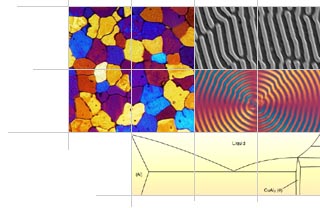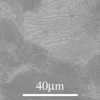Micrograph Library
Browse the libraryAdvanced searchSystemsCompositionsTechniquesKeywordsPhase diagramsHelpPreferencesAbout the micrograph libraryTerms of useContribute micrographs!FeedbackLinksCredits Print this page

Full Record for Micrograph 15

[61 KB]
View micrograph
.. in new window
View micrograph and record
.. in new window
You can also view and download the micrographs on Flickr
- Micrograph no
- 15
- Brief description
- Fe, C 0.8 (wt%), eutectoid transformation - pearlite (coarse)
- Keywords
- alloy
 , austenite
, austenite  , carbon, cementite
, carbon, cementite  , eutectoid reaction
, eutectoid reaction  , ferrite
, ferrite  , iron, lamella
, iron, lamella  , metal, pearlite
, metal, pearlite  , steel
, steel  , supercooling
, supercooling 
- Categories
- Metal or alloy
- System
- Fe-C-X

- Composition
- Fe, C 0.8 (wt%)
- Standard codes
- Reaction
- Processing
- Slow cooled
- Applications
- Sample preparation
- Technique
- Reflected light microscopy
- Length bar
- 40 μm
- Further information
- This steel is of the eutectoid composition. Once the temperature is lowered below the eutectoid temperature the steel becomes simultaneously supersaturated with both ferrite and cementite. A eutectoid transformation results (g to a + Fe3C). The resultant microstructure, known as pearlite, comprises lamellae of cementite (dark) embedded in ferrite (white). The platelets are parallel to each other and do not follow a specific crystallographic direction.
Each pearlite colony is made up of a number of subgrains. Thus each pearlite colony consists of two interpenetrating single crystals having an orientation relationship with respect to each other and with respect to the austenite grain they grow from, but not with respect to the austenite grain they have grown into. Changes in the apparent interlamellar spacing from colony to colony in the photograph are due to differences in the lamellae spacing with respect to the polished surface.
The coarseness of the pearlite is determined by the interlamellar spacing. This spacing is inversely proportional to the undercooling. This is primarily because of the increased rate of carbide nucleation with increased undercooling.
The pearlite in this sample is coarse due to it being slowly cooled. The undercooling is low so the lamellae spacing is relatively large resulting in a coarse microstructure. - Contributor
- Prof T W Clyne
- Organisation
- Department of Materials Science and Metallurgy, University of Cambridge
- Date
- 25/10/01
- Licence for re-use
 Attribution-NonCommercial-ShareAlike 4.0 International
Attribution-NonCommercial-ShareAlike 4.0 International- Related micrographs

